Printing Nikkor 105 mm f/2.8 AThis page discusses the Printing Nikkor 105 mm f/2.8 A, and its performance in macrophotography. The Printing Nikkor series is designed for high performance, usually at a single optimal magnification. All lenses in this series use complex optical schemes with numerous elements. The Printing Nikkor A series is more recent than the original Printing Nikkors, and uses even more complex optical schemes. The Tochigi Nikon Rayfact 1x 105 mm f/2.8 is currently available and has similar specifications to the Nikon Printing Nikkor 105 mm f/2.8 A (and a slightly larger image circle than the latter). At the rear of the adapter is a stack of extension tubes ending in a Nikon BR2A reversing ring and a Metabones Nikon F to Micro 4/3 adapter. The extension tubes and adapters in the figure achieve a 1x magnification. The Nikon Printing Nikkor 105 mm f/2.8 A is housed in a rather long and heavy barrel with a manual aperture ring ranging from f/2.8 to f/11 with half-stop clicks. The diaphragm has 12 blades and the aperture is very evenly round. This lens is specified for an optimal magnification of 1x, and rated by Nikon as usable from 0.75x to 1.5x. This lens provides a 54 mm image circle at 1x, and is designed mainly as a film copying lens. The stack of extension tubes and adapters shown in the above picture yields a 1x magnification on Micro 4/3. All Printing Nikkors in the original (non-A) series use optical schemes with 12 elements in 4 groups. This means that, of the 24 optical surfaces, only 8 are of the air-to-glass type, which is the type most likely to cause reflections and flare. Glass-to-glass surfaces do have an adhesive between adjacent elements, but the difference in refraction index between glass and adhesive is much lower than between glass and air, and glass-to-glass surfaces are therefore less likely to cause reflections and flare. The Printing Nikkor 105 mm f/2.8 A uses a formula with 14 elements in 6 groups, more complex than the original Printing Nikkors. The original Printing Nikkors apparently used some elements made with glass containing toxic (lead, arsenic) and/or potentially radioactive (lanthanum) elements. The redesign of these lenses was possibly triggered by an EU ban on these types of glass. As to why the Nikon lens designers increased the number of glass-to-air surfaces when they redesigned the Printing Nikkor A series, two cemented elements must have the same surface curvature (of complementary sign of course) of the cemented surface, while air-spaced adjacent elements can have a different curvature. This adds one more degree of freedom that lens designers can use to correct aberrations, thus compensating for the restrictions of types of glass. Modern lens coatings are more effective than older ones, so modern lenses can have a larger number of air-spaced elements without decreased contrast and increased sensitivity to flare. Mounting the lensThis lens has an unusual M45x0.75 male mounting thread. The lens must be mounted in a pass-through adapter with an inner diameter and length sufficient to house the rear of the lens, which projects far behind the mounting flange. This is a relatively heavy lens, and requires a long extension from mounting flange to focal plane at 1x. Therefore, the lens adapter should provide an attachment (lens collar or a similar fixture) to attach the lens to a support. This attachment should also be able to support the weight of the camera body. A proper alignment of the lens is also important. The setup shown near the top of this page uses an Arca-compatible long-lens plate equipped with two small screws that prevent twisting of the lens collar around its 1/4-20 bolt. RafCamera sells an adapter that screws around the male M45x0.75 lens attachment and provides a male M52 thread. This is the only commercial, easily obtainable adapter for the Printing Nikkor 105 that I know of. A BR2A cannot be attached immediately at the rear of the Rafcamera adapter, because the interior of the BR2A is too narrow for the rear barrel of the Printing Nikkor 105. A stack of 52 mm extension tubes can be placed between adapter and BR2A (above figure). Nikon bellows or a Nikon PN-11 extension ring can then be attached at the rear of the BR2A to provide a way to support the lens. Another alternative is to use an M52 helicoid between Rafcamera adapter and BR2a. These solutions are not as well balanced as the custom adapter shown above. The front of the lens barrel carries a short extension tube with two different female threads. This ring carries a front female M43 filter thread, and attaches at its rear to a male M45 thread located around the front element. The latter thread can be used to mount the lens in a reversed orientation if there should be a need for this. It is however likely that the optical formula of this lens (which Nikon seems to have kept a secret) is symmetric, so there is no good reason for reversing this lens. Using the lens in practiceThis lens is designed to provide the maximum resolution already fully open at f/2.8 (the older, non-A version is probably best at f/3.5). This lens can be stopped down from f/2.8, but it does not have to in order to achieve the best image quality. This also means that image quality inevitably becomes reduced by diffraction when the lens is stopped down from f/2.8 (albeit half a stop or one stop have only a small effect). It makes therefore little sense to purchase this lens and then routinely stop it down to f/8 or f/11. At these apertures, many far cheaper macro lenses provide a comparable image quality. The large majority of macro lenses, on the other hand, need to be stopped down to at least f/4 or f/5.6 to sufficiently improve their image quality (not just their DOF), and their f/2 or f/2.8 apertures are mostly useful to provide a brighter viewfinder for framing and focusing before stopping down for the exposure. Unless the subject is very flat and all its important features lie within the DOF, the application that fully utilizes the capabilities of this lens is focus stacking. The image circle of this lens is more than enough to cover a full frame sensor, and this lens probably outresolves all currently available full-frame sensors. This lens can be used on sensors as small as Micro 4/3, but on this format the contest between lens resolution and sensor resolution is a closer call. In particular, without testing it cannot be decided whether the extended resolution mode of some Micro 4/3 cameras, which combines eight exposures taken at sensor shifts of half a pixel, exceeds the capabilities of this lens. This mode produces up to 80 Mpixel images on the Olympus E-M1 Mark II. The real resolution is obviously improved even to casual comparison by eye with the native sensor resolution of 20 Mpixel. For best results, this mode requires very accurate focusing (which is problematic at high magnification, since no live view is available beyond the 20 Mpixel native sensor resolution, and one cannot rely on excess DOF to compensate for small focusing errors), lack of vibration (also problematic because of the unavoidable physical stepping of the sensor) and subject movement. Results are not equivalent to an 80 Mpixel sensor, mainly because of partial overlap of the shifted pixels. However, overall resolution is better than the physical pixel size, for a number of reasons including the fact that sensor shifts allow the successive recording of data at the same point with red, green and blue sensels, in addition to half-pixel intermediate positions. This eliminates one of the intrinsic resolution limitations of Bayer sensors. My impression is that, in the best cases, results are roughly equivalent to a 40 to 50 Mpixel native resolution. This is equivalent in absolute pixel pitch to a 160-200 Mpixel full-frame sensor, and is likely to exceed the resolution of legacy and current lenses designed for ordinary cameras. The test camera allows the in-camera generation of 50 Mpixel images scaled down from the original 80 Mpixel computed data. I can see no significant difference (in terms of real resolution) between 80 and 50 Mpixel images, and therefore for this test I am using the 50 Mpixel format. Tests by other usersThis is a well-known lens among macrophotographers. Numerous examples of its capabilities are available online, see for example the extensive test on coinimaging.com. The general consensus is that you cannot go wrong with this lens at magnifications around 1x and sensor size up to full frame. On the other hand, the purpose of this page is to test the lens on Micro 4/3. There is an earlier test of this lens on Micro 4/3 that includes also enhanced resolution mode and the use of focal length multiplier and SpeedBooster, with results party different from those of my tests (see below). These differences may be explained by the use of a different focal length multiplier and (possibly) of a different version of SpeedBooster (there are currently multiple versions of SpeedBooster with different optics, and the optics may also have been upgraded over the years). In particular, all earlier tests agree on the lack of axial and transversal chromatic aberration of this lens. I obtained the same results in this respect, and for this reason I will not show the results of this particular test. Lens resolution test
Initial tests showed the importance of using internal flocking and/or baffles in extension tubes to cut flare and loss of contrast. This is especially true when stopping down (above figure). The large image circle produced by the lens is one of the causes of low contrast, especially on a small sensor. Off-center light is reflected and diffused by the interior of the extension tubes. In my case, flocking the whole interior of the extension tubes with Protostar solved this problem, at least in the visible range. 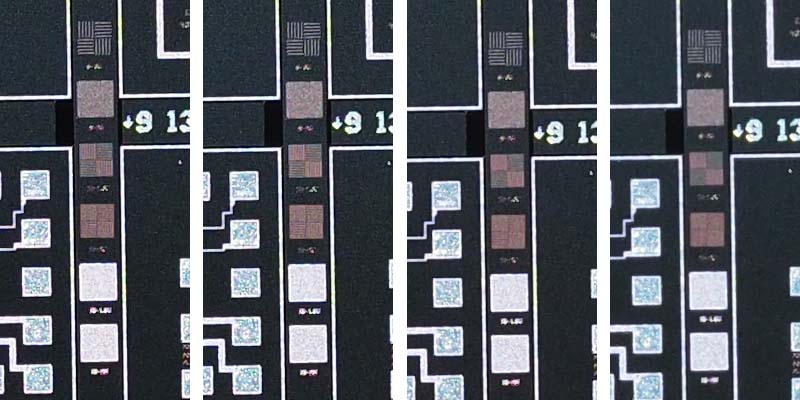
In spite of the low magnification at 1x, the resolution of this lens is so high across the frame that the resolution targets I used in other lens tests were not suitable. For the present test, I used a silicon wafer that includes numerous test patterns (it may in fact be a wafer fabricated for test purposes). The line patterns shown above, arranged in a column of squares along the middle of each crop, are good for this purpose. The third and fourth of the squares from the top, in particular, are at the resolution limit of this combination of this combination of lens and camera. The lines are close to 1 pixel-wide, and about equally defined at f/2.8 and f/4. They are almost invisible at f/5.6, and definitely gone at f/8. The lines in the topmost square remain well resolved at all apertures. The text labels under each square are unreadable. 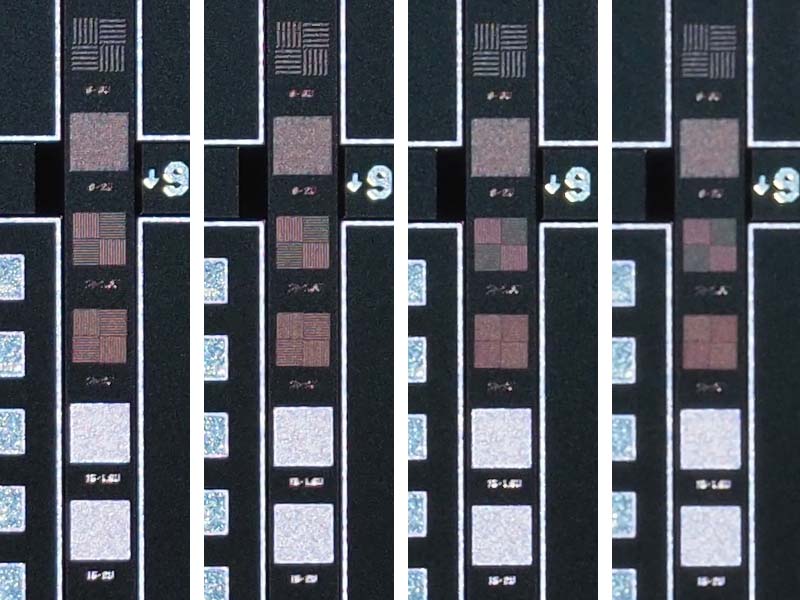
Adding two extension tubes, each 28 mm long, produces a magnification of 1.44x. At this magnification, flatness of field and resolution remain uniform across the frame. The line patterns in the third and fourth squares from the top are clearer than at 1x, which means the increased magnification results in more real detail (i.e., not empty magnification) at f/2.8 and f/4. Additionally, some of the labels under the squares are now barely readable. Resolution at f/2.8 and f/4 is quite similar, with only a hint of diffusion blur at f/4. A little more detail than at 1x is also visible at f/5.6 and f/8. While resolution at the center of the frame is excellent, there is an asymmetric blurring (perhaps astigmatism) all over the periphery at f/2.8. It is strongly reduced at f/4, and gone at f/5.6. The lens is clearly outside its optimal magnification at 1.44x and f/2.8, but still usable at f/4. 
By removing one of the 28 mm rings from the setup that produces 1x, a magnification of 0.65x is obtained. The coarsest of the test squares (at the top of the column) is still resolved, but none of the others. Sharpness at f/2.8 and f/4 is very similar, oddly a little sharper at f/4 than f/2.8. There is a coarser line pattern at the bottom right in the above crops, which is resolved up to f/5.6. The peripheral regions of the frame are degraded, about to the same extent as at 1.44x. Asymmetric peripheral blur is evident at f/2.8, reduced at f/4 and gone at f/5.6. As a whole, the best aperture at this magnification is f/4, followed by f/5.6. 
left: 1x, center: 1.44x, right: 0.65x. The above figure shows the extreme corner of the frame at different magnifications (not the same corner). It is obvious that only the 1x image provides excellent image corners. Enhanced resolution mode50 Mpixel enhanced resolution is best used at 1x only, because of the degradation of peripheral image quality at other apertures, and the overall diffraction blur that accompanies stopping down to correct the peripheral degradation. 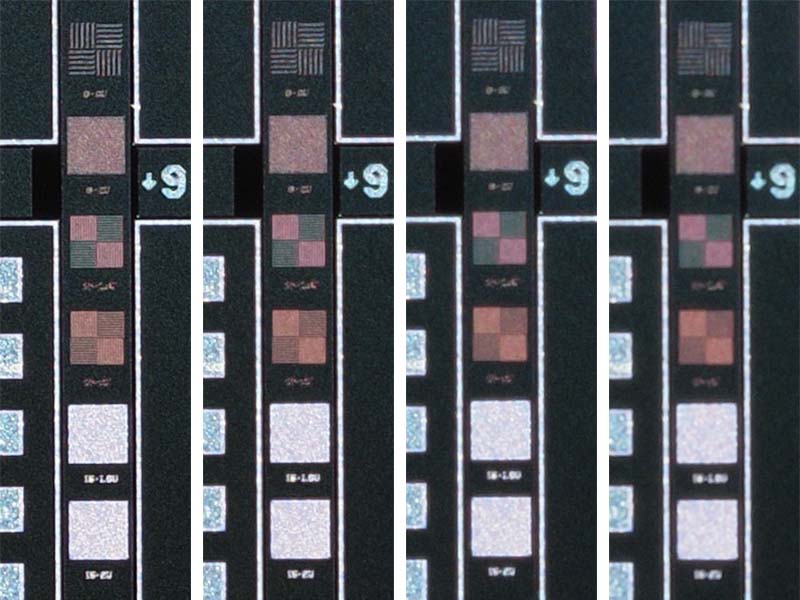
The resolution differences among different apertures are more marked in the 50 Mpixel images. The difference between f/2.8 and f/4, in particular, is very visible. 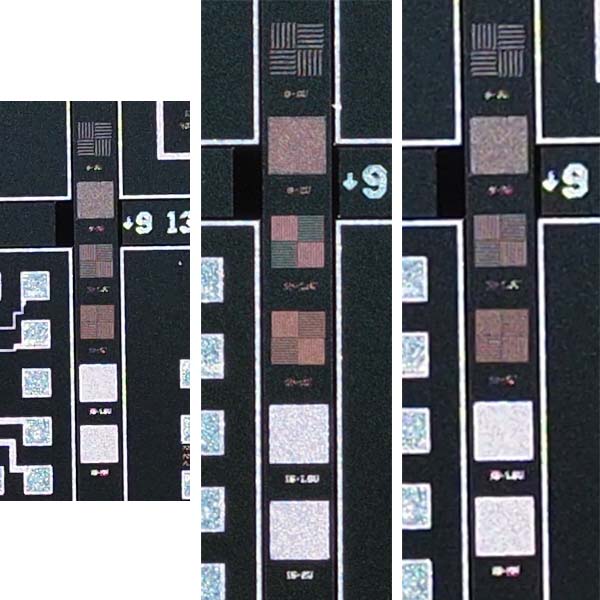
The above picture shows, for comparison, the same detail in the 50 Mpixel image and in the 20 Mpixel image. A few dust specks had time to settle on the test subject between shots. The latter was upscaled by cubic interpolation at the right. My conclusion is that the difference in enhanced resolution is significant, although not dramatic. In turn, this means that the Printing Nikkor 105 mm effectively outresolves the Olympus E-M1 Mark II at its native resolution of 20 Mpixel. Image quality in 50 MPixel mode remains constant across the frame at 1x. Because of this, it is effectively better to use the lens at 1x in 50 Mpixel mode (and crop if necessary), than at 1.44x in 20 Mpixel mode. SpeedBooster and focal length multiplierOne last thing to test is the performance of this lens coupled to a SpeedBooster (to reduce the effective focal length of the lens, and thereby its optimal magnification) and a focal length multiplier (to achieve the opposite result). Initial tests with a Metabones Speed Booster to achieve a lower magnification than 1x were disappointing. Although this same Speed Booster works well with lenses of short focal length, it produces dark corners with the Printing Nikkor 105 mm at 1x. The main cause of this vignetting is likely the high distance between lens rear element and Speed Booster. 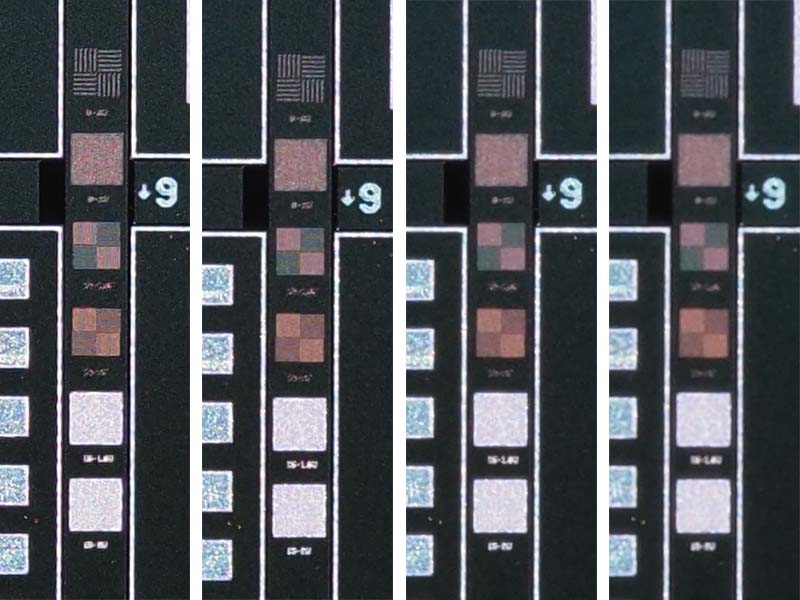
1:1 pixel crops, from the left: f/2.8, f/4, f/5.6, f/8. 
1:1 pixel crops, from the left: f/2.8, f/4, f/5.6, f/8. A high quality Olympus MC-14 1.4x focal length multiplier likewise shows limitations in image quality when used with this lens. Resolution at effective 1.4x in the center of the image is lower than by pushing the lens to 1.4x by extending its distance from the sensor, or by shooting in 50 Mpixel mode and cropping. Contrast is also a little lower than either alternative. The situation is worse in the peripheral areas, which display a little lower resolution, significantly lower contrast, a little pincushion distortion and a moderate transversal chromatic aberration. Stopping down the lens corrects none of these problems. A positive note is that the corners do not display the asymmetric blurring introduced in the corners at f/2.8 (and a little remaining at f/4) by extending the lens. ConclusionsThe Nikon Printing Nikkor 105 mm f/2.8 A confirms its fame as an extremely sharp lens at 1x, even on Micro 4/3 and even in Micro 4/3 50 Mpixel enhanced resolution. It further displays flat field, lack of all chromatic aberration, lack of vignetting and uniform image quality across the Micro 4/3 frame. Pushed to 0.65x and 1.44x, however, it shows a degradation in the peripheral areas even on this small format. |